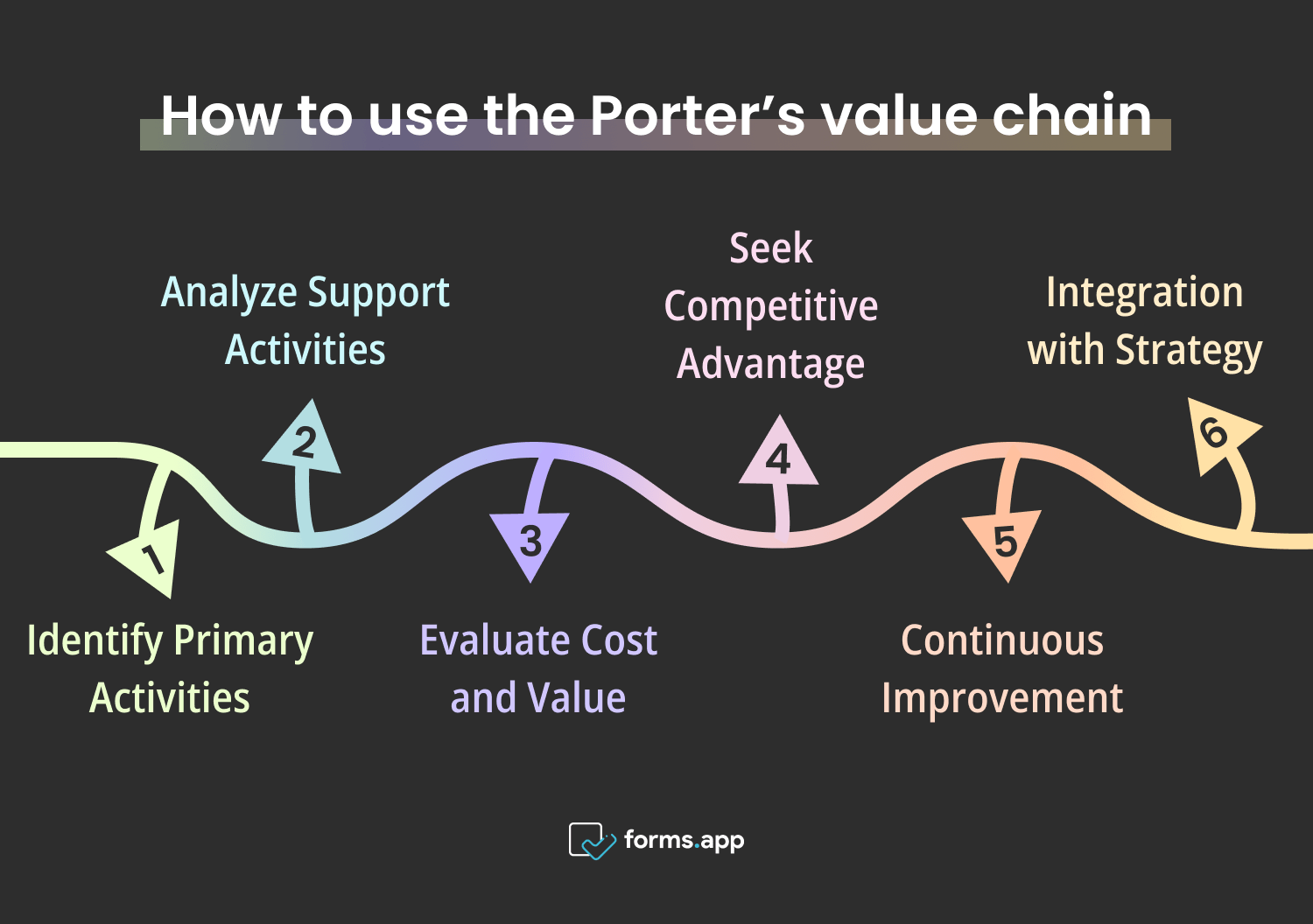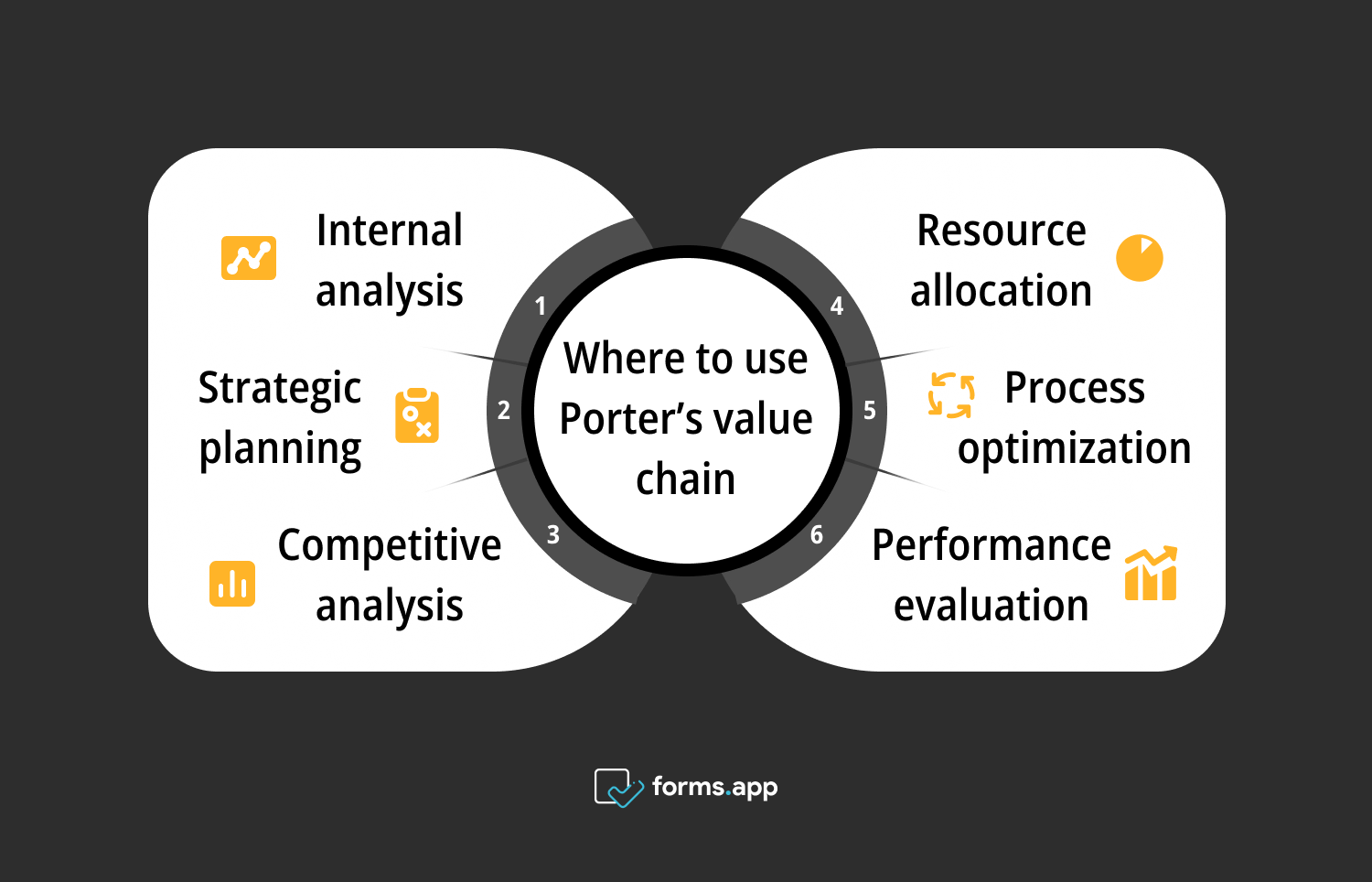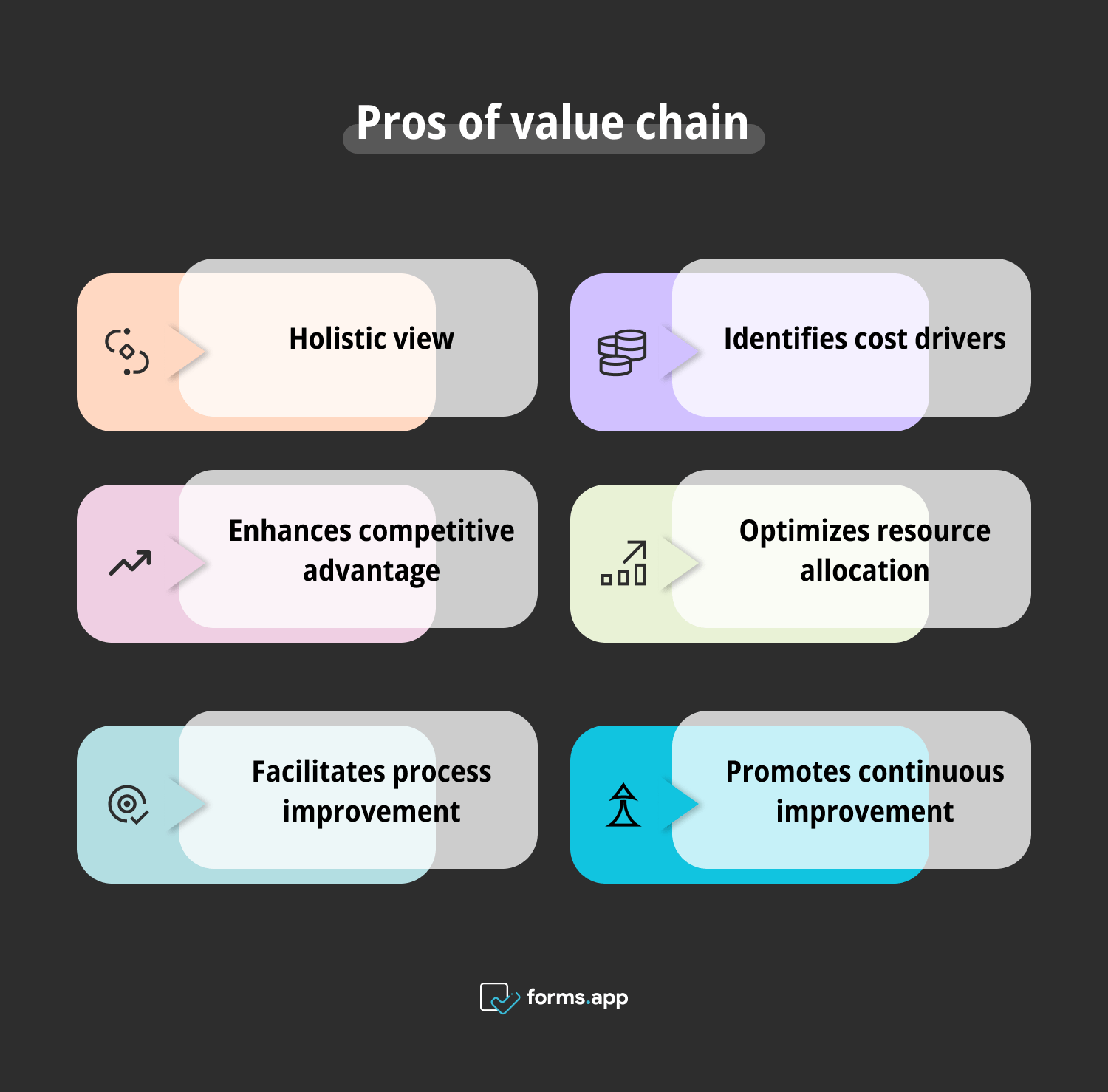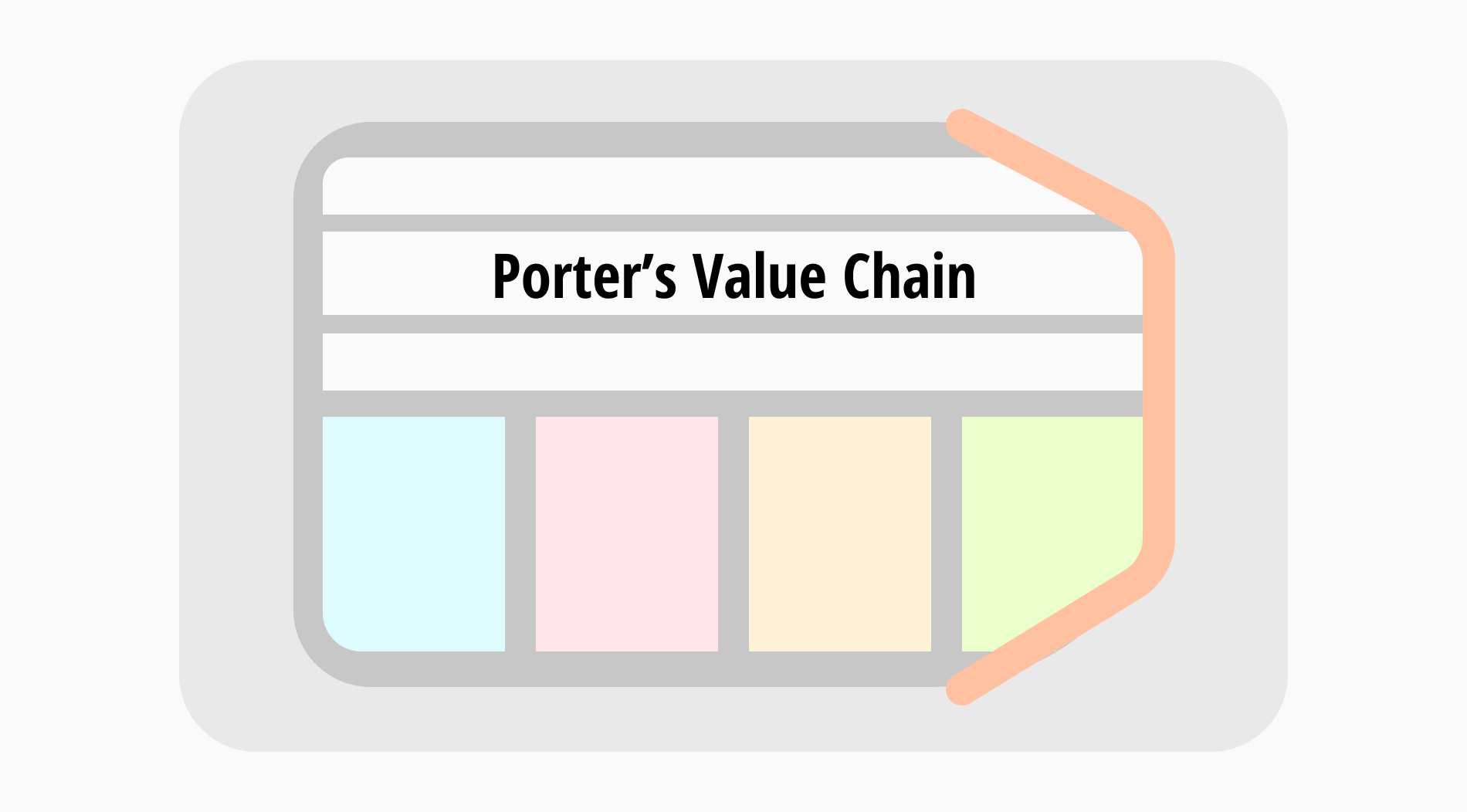In today’s fast-paced and competitive business landscape, understanding and analyzing internal activities are critical for success. These concepts provide invaluable frameworks for businesses to categorize their operations and identify areas for improvement. By leveraging such tools, companies can streamline processes, enhance efficiency, and deliver greater value to their customers.
Today, we delve into one of these concepts: Michael Porter’s Value Chain. We’ll explore its details, step by step, its components, and its scope across various business environments. Moreover, we’ll discover its advantages in terms of optimizing operations and gaining a competitive advantage. Lastly, we’ll address common questions to ensure a comprehensive understanding of this vital framework.
What is Porter’s value chain?
Porter's value chain is a concept developed by Michael Porter to analyze a company's internal activities in order to identify strategic opportunities for competitive advantage.
It breaks down a company's operations into primary and support activities, highlighting where to create value and how to minimize the costs.
Porter’s value chain: The diagram explained
Porter’s Value Chain model presents a structured framework for businesses to analyze their internal operations. It helps them understand how to create value throughout the production process. The activities include a comprehensive view of the steps involved in delivering a product or service to customers. Primary activities include inbound logistics, operations, outbound logistics, marketing, and sales and service.
Support activities, on the other hand, provide the foundation necessary to facilitate the primary activities effectively. These include a firm infrastructure, human resources, technology development, and procurement. These are all essential components in optimizing operational efficiency and enhancing value creation. By carefully examining each activity within the value chain, businesses can identify opportunities to reduce costs and process improvement.
The value chain concept highlights the connection of various business functions and importance of each activity for value generation. Through strategic analysis and optimization of both primary and support activities, companies can manage processes and improve resource allocation. This enables delivering superior products to their customers. The holistic approach strengthens businesses to stay agile, responsive and competitive.
How to use the Porter’s value chain
There are several steps to conduct a successful value chain analysis. By following these steps, the companies can recognize their internal dynamics. They can stay one step ahead of their competitors, identifying and evaluating the areas for improvement. Let’s discover the steps:

Steps for Porter’s value chain
1- Identify Primary Activities
Start by charting the core processes involved in delivering your product or service. This entails detailing the flow of inbound logistics, operations, and the efficiency of outbound logistics. It also involves the efficiency of marketing and sales efforts and the quality of post-sale service. Understanding these fundamental activities is vital for comprehending the value creation journey.
2- Analyze Support Activities
Delve into the foundational pillars supporting primary operations. Examine the robustness of your infrastructure carefully. Review the efficiency of your human resources management, the innovation drive in technology development, and the efficiency in procurement processes. Each support activity should complement and elevate the performance of primary operations to maximize value creation potential.
3- Evaluate Cost and Value
Conduct a thorough examination of each activity to categorize its cost implications and value contribution. This involves assessing the expenses for each step and evaluating the value added to the product or service. Identifying areas to minimize costs without compromising value is essential for operational optimization and enhanced profitability.
4- Seek Competitive Advantage
Use insights gained from the value chain analysis to identify avenues for gaining a competitive edge. This involves identifying key activities to achieve differentiation, whether through cost leadership, product differentiation, or focus business strategy. Leveraging these strategic insights allows businesses to outperform competitors in delivering value to customers.
5- Continuous Improvement
Embrace a culture of perpetual enhancement by fostering an environment where innovation thrives. Stay attuned to shifts in market dynamics, emerging technologies, and evolving customer preferences. Regularly revisit and refine operational strategies to ensure alignment with overarching business goals and to capitalize on new opportunities for value creation.
6- Integration with Strategy
Seamlessly integrate insights garnered from the value chain analysis into the broader strategic framework of the organization. Align operational decisions with long-term strategic objectives to ensure coherence and synergy across all facets of the business. By embedding value chain optimization into strategic planning processes, businesses can fortify their competitive position.
By adhering to each of these steps, businesses can optimize their operational processes and cultivate a culture of innovation. This holistic approach empowers organizations to adapt to evolving market dynamics. It helps them deliver unparalleled value to customers and solidify their position as industry leaders in the business landscape.
Where to use the Porter’s value chain
Michael Porter’s value chain model is applicable in various business industries and environments. In many sectors and types of work, it is useful in many ways, from strategic business planning to resource allocation. Let’s see some of these suitable environments:

Right times to use value chain
- Internal analysis: Porter's Value Chain is instrumental for conducting internal analyses within organizations. By examining each activity in the production and delivery of goods or services, businesses gain profound insights into their operational strengths, weaknesses, and areas for improvement.
- Strategic planning: It serves as a cornerstone in strategic planning processes. Businesses can align their value chain analysis with strategic goals. This ensures that operational decisions are coherent and conducive to long-term success.
- Competitive analysis: Utilizing the value chain model enables businesses to conduct comprehensive competitive analysis. By comparing the efficiency and effectiveness of their value chain activities with those of competitors, organizations can identify opportunities for differentiation and competitive advantage.
- Resource allocation: Value chain analysis informs resource allocation decisions within organizations. By identifying activities with the highest value-added contribution and optimizing resource allocation accordingly, businesses can enhance operational efficiency and profitability.
- Process optimization: It facilitates process optimization efforts within organizations. By identifying inefficiencies or bottlenecks in value chain activities, businesses can implement targeted improvements to streamline processes and enhance overall operational performance.
- Performance evaluation: Porter's Value Chain provides a framework for evaluating organizational performance. The companies can regularly assess the cost and value-added contribution of each activity. They can track progress, identify areas for further improvement, and drive continuous enhancement initiatives.
Businesses can gain a holistic understanding of their internal operations, align their activities with strategic objectives, and identify sources of competitive advantage. They can also optimize resource allocation, streamline processes, and drive ongoing performance improvement efforts. This comprehensive approach empowers organizations to enhance their competitive position and achieve sustained success in dynamic market environments.
Advantages of the Porter’s value chain
This useful model also has many advantages for businesses. They range from identifying the cost drivers to promoting continuous improvement. Let’s look at these advantages in detail and get a more comprehensive understanding of Porter’s value chain:

Benefits of the value chain
- Holistic view: Porter's Value Chain provides a holistic view of a business's internal operations. It enables organizations to understand the entire value creation process, from raw materials to finished product or service delivery.
- Identifies cost drivers: It helps identify cost drivers within the value chain. It also allows businesses to pinpoint areas to minimize the cost without compromising product or service quality assurance.
- Enhances competitive advantage: By analyzing each value chain activity, businesses can identify opportunities for differentiation and competitive advantage. This enables them to position themselves more effectively in the marketplace.
- Optimizes resource allocation: Value chain analysis enables more informed resource allocation decisions. Because, organizations can allocate resources to activities with the highest value-added contribution, thereby maximizing efficiency and profit margin.
- Facilitates process improvement: It serves as a roadmap for process improvement initiatives. The businesses can identify inefficiencies or bottlenecks in value chain activities and implement targeted improvements to enhance overall operational performance.
- Promotes continuous improvement: Value chain analysis fosters a culture of continuous improvement within organizations. This is due to its providing a framework for ongoing performance evaluation and enhancement. It ensures that businesses remain agile and responsive to changing market conditions.
With these advantages of Porter's Value Chain, businesses can gain deeper insights into their internal operations. They can also optimize resource allocation, enhance competitive advantage, and drive continuous improvement initiatives. It will ultimately help them position themselves for long-term success in dynamic market environments.
Example of the Porter’s value chain
In the scenario of our Porter’s value chain example, Company ABC, a manufacturer of consumer electronics, decides to implement Porter's Value Chain concept. It wants to improve its operational efficiency and gain a competitive edge in the market. The company’s other goals are to look for areas for improvement and stay ahead of their competitors.
Firstly, ABC conducts a thorough analysis of its value chain and identifies inefficiencies in its inbound logistics. This is particularly true in sourcing raw materials and managing inventory. Through relationships with suppliers and the implementation of advanced inventory management systems, ABC streamlines its supply chain. This helps them reduce lead times and lower procurement costs.
With a more efficient supply chain in place, ABC shifts its focus to optimizing its production operations. By leveraging technology and automation, the company improves manufacturing processes, reduces waste, and increases production throughput.
Additionally, ABC invests in employee training and research and development programs to enhance workforce skills and productivity. As a result, the company is able to deliver high-quality products to customers more quickly and cost-effectively. This strengthens its position in the competitive consumer electronics market.
Furthermore, with a deep understanding of its value chain activities, ABC identifies opportunities for product differentiation and innovation. Through continuous monitoring and optimization of its value chain, Company ABC achieves sustainable growth. It also solidifies its market position, and becomes a trusted leader in the consumer electronics industry.
Frequently asked questions about Porter’s value chain
The primary purpose of Porter's Value Chain analysis is to help businesses understand the sequence of activities involved in delivering a product or customer service. By dissecting these activities, organizations can identify opportunities for cost reduction, process improvement, and differentiation, ultimately enhancing their competitive advantage.
There are many strategic frameworks such as value curve and the customer lifetime value (clv). Unlike other strategic frameworks focusing on external factors such as market dynamics and competitive forces, Porter's Value Chain emphasizes internal operations. It provides a systematic approach for analyzing how businesses create value through their internal activities, offering insights into operational efficiency and competitive positioning.
Yes, Porter's Value Chain applies to service-based industries just as effectively as it does to manufacturing. While the specific activities may differ, the fundamental principles of value creation through internal operations remain the same. Service businesses can use the framework to identify opportunities for service improvement, cost reduction, and differentiation.
The frequency of value chain analysis depends on the industry, market dynamics, and internal factors within the organization. However, conducting a value chain analysis at least annually ensures that businesses recognize the changes in their sector. This also helps them adapt their strategies accordingly.
One common challenge is obtaining accurate and comprehensive data for each value chain activity, especially in complex organizations with multiple departments and stakeholders. Additionally, ensuring cross-functional collaboration and buy-in from all levels of the organization can be challenging. But it is essential for successful implementation and adoption of value chain analysis.
Conclusion
To sum up, the Porter’s value chain helps companies book competitive advantage, creating and sustaining superior performance. It allows companies to evaluate their internal dynamics and identify rooms for improvement. By creating a value chain, they can deliver goods/services of higher quality and constantly improve their activities.
In this full guide, we have covered both pillars, the primary and support activities, of Porter’s value chain. We have discovered its steps to follow, suitable environments, and advantages. We have also seen a scenario where a company using this model obtains positive results. Last but not least, we answered some common questions about the subject.
It is now your turn to create a value chain!
Fatih is a content writer at forms.app and a translator specializing in many text domains, including medical, legal, and technical. He loves studying foreign languages. Fatih especially likes to create content about program management, organizational models, and planning tools.



